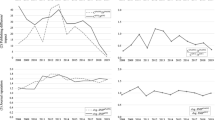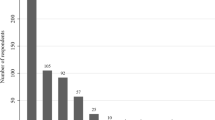Abstract
This work broadens the perspective on academic attention, to tackle the key economic problem of how to allocate scarce attention, and what kinds of dynamics this situation can foster. Focusing on selected fields and using standard tools of industrial organization, we delineate the trends in the market for academic attention over 14 years, and attempt to provide an interpretation. We find a tendency toward progressive market concentration, and also that specific strategies adopted by players, aside from the usual benefits determined by price discrimination, can produce subsidies of attention from well-known journals to lesser-known journals belonging to the same bundle. This may influence readers’ and authors’ choices of how to direct their attention.
Similar content being viewed by others
Notes
See e.g. Tribe (2006). The estimated number of papers published in 2006, based on Ulrich’s database gathering detailed information on more than 300,000 periodicals of all types, is 1,350,000 in approximately 23,750 scholarly journals (Björk et al. 2009). The average annual growth rate between 1995 and 2007 was + 2.5% (http://www.nsf.gov/statistics/seind10/c5/c5h.htm). According to Ulrich’s, the number today is more than 2.5 million.
Stylistic devices are essentially techniques used to impart an auxiliary meaning to a written text or to a speech, painting, etc. Examples include allegory, metaphor, symbol and many others. By saying something other than in an ordinary way, they attract attention. These devices are heavily exploited in society. A simple and very accessible example are the road signs used for attracting drivers' attention to issue directions relevant to the circulation of traffic (Lanham 2006).
Interestingly, a referee underlines that this social cascade, triggering a sort of demand-network externality dynamics, accounts for the highly skewed distribution of attention. Although this phenomenon can be considered somewhat ‘natural’, in the rest of the article we will show that it can be further manipulated to increase the skewedness.
e.g. The success of the newly introduced journals by the American Economic Association can be to a large extent explained by the scientific reliability of the association itself (Cavaleri et al. 2009).
Of course this does not imply that the impact factor represents, per se, the best system, and there are many critical voices (see e.g. Ramdsen 2009).
The citations pattern seems to follow this orientation. Migheli and Ramello (2014) performed a test on a sample of journals listed under economics in a different and wider database, Scimago, and showed that the average citations are higher for journals listed in the JCR, and that this difference is statistically significant.
However, it must be noted that IFs are average citations of articles published in a journal in a given range of years; therefore the presence of superstar articles (i.e. papers that receive hundreds of citations) may hide that of ’dry holes‘ (i.e. articles without citations). Laband (2013) and Torgler and Piatti (2013) present evidence for the high level of citation inequality that characterises many top journals in economics. Nevertheless, these superstars are terrific attractors of attention, as the number of citations received proves. However, this fact does not alter our analysis: superstar articles contribute to concentrate the attention of scholars on the journals where they are published.
In other words, although it is questionable to assert that journals not listed in the JCR are inferior in terms of quality to those listed (see e.g. Migheli and Ramello 2014 for economics), it is true that, under the existing system, being listed in the JCR ensures the journal has a minimal endowment of quality.
The issue was, rather, to obtain access to the few available journals. To meet the excess of demand the French Journal des Sçavans (later renamed Journal de Savants) led to the flourishing of pirate publications (Ramello 2010).
For example, according to the Association of Research Libraries, a non-profit organization of 125 research libraries in North America including many academic libraries, between 1986 and 2004 the expenditure for serials rose by more than 273% and the average price of a serial by more than 188%, compared with a 73% increase in the consumer price index (Ramello 2010).
We can cite, in chronological order, the Faculty Advisory Council Memorandum on Journal Pricing of Harvard University, eloquently subtitled “Major Periodical Subscriptions Cannot Be Sustained” (see: http://isites.harvard.edu/icb/icb.do?keyword=k77982&tabgroupid=icb.tabgroup143448).
One could argue that it depends on the inability of new journals to be listed in JCR. But this is not the case because, in all the fields, JCR is expanding the lists of journals and there are newcomers joining the markets of academic attention.
For all the studied fields, the correlation index is quite high, ranging from 0.68 in business to 0.98 in business and finance.
The ISI Thomson website provides the procedure for being considered by JCR. However in a number of private interviews, editors told us that the whole evaluation process, including the final decision, is quite opaque.
References
Althouse, B. M., West, J. D., Bergstrom, C. T., & Bergstrom, T. (2009). Differences in impact factor across fields and over time. Journal of the American Society for Information Science and Technology, 60, 27–34.
Beniger, J. R. (1986). The control revolution: Technological and economic origins of the information society. Cambridge: Harvard University Press.
Björk, B. C., Roos, A., & Lauri, M. (2009). Scientific journal publishing: yearly volume and open access availability. Information Research, 14. http://informationr.net/ir/14-1/paper391.html
Bordalo, P., Gennaioli, N., & Shleifer, A. (2013). Competition for Attention, NBER working paper n. 19076
Boyer, J. (1947). Création du Premier Journal Scientifique. La Nature, pp. 243–244. http://www.gloubik.info/sciences/IMG/pdf/3141-journal-des-savants.pdf
Bradford, S. C. (1934). Sources of information on specific subjects. Engineering, 137, 85–86.
Cavaleri, P., Keren, M., Ramello, G. B., & Valli, V. (2009). Publishing an E-Journal on a shoe string: Is it a sustainable project? Economic Analysis & Policy, 39, 89–101.
Curry, B., & George, K. D. (1983). Industrial concentration: A survey. Journal of Industrial Economics, 31(3), 203–255.
Davenport, T. H., & Beck, J. C. (2001). The attention economy: Understanding the new currency of business. Harvard, MA: Harvard Business School Press.
Dewatripont, M., Ginsburgh, V., Legros, P., Walckiers, A., Devroey, J. P., Dujardin, M., et al. (2006). Study on the economic and technical evolution of the scientific publication markets in Europe. Brussels: European Commission.
Donsimoni, M. P., Geroski, P., & Jacquemin, A. (1984). Concentration indices and market power: Two views. Journal of Industrial Economics, 33(4), 419–434.
Edlin, A. S., & Rubinfeld, D. L. (2004). Exclusion or efficient pricing? The “big deal” bundling of academic journals. Antitrust Law Journal, 72, 128–159.
Eger, T., Scheufen, M., & Meierrieks, D. (2015). The determinants of open access publishing: Survey evidence from Germany. European Journal of Law and Economics, 39, 475–503.
Federal Trade Commission & Department of Justice. (2010). Horizontal mergers guidelines. Washington, DC: Government Printing Office.
Feess, E., & Scheufen, M. (2016). Academic copyright in the publishing game: A contest perspective. European Journal of Law and Economics, 42, 263–294.
Garfield, E. (2006). The history and meaning of journal impact factor. Journal of the American Medical Association, 295, 90–93.
Havemann, F., Heinz, M., & Wagner-Döbler, R. (2004). Firm-like behavior of journals? Scaling properties of their output, and impact growth dynamics. Journal of the Association for Information Science and Technology, 56(1), 3–12.
Johns, A. (2000). Miscellaneous methods: Authors, societies and journals in early modern England. British Journal of History of Science, 33, 159–186.
Kahneman, D. (1973). Attention and effort. Englewood Cliffs, NJ: Prentice Hall.
Kaplow, L., & Shapiro, C. (2007). Antitrust. In A. M. Polinsky & S. Shavell (Eds.), Handbook of law and economics (Vol. 2, pp. 1073–1226). Amsterdam and Oxford: North-Holland.
Klamer, A., & van Dalen, H. P. (2002). Attention and the art of scientific publishing. Journal of Economic Methodology, 9, 289–315.
Laband, D. M. (2013). On the use and abuse of economics journals rankings. The Economic Journal, 123, F223–F254.
Lanham, R. A. (2006). The economics of attention. Chicago, IL: The University of Chicago Press.
Larivière, V., & Gingras, Y. (2010). The impact factor’s matthew effect: A natural experiment in bibliometrics. Journal of the Association for Information Science and Technology, 61(2), 424–427.
Martin, S. (1999). Strategic and welfare implications of bundling. Economic Letters, 61, 371–376.
McCabe, M. & Snyder, C. (2014). Identifying the effect of open access on citations using a panel of science journals. Economic Inquiry (in press).
McCain, K. W. (2014). Obliteration by incorporation. In B. Cronin & C. R. Sugimoto (Eds.), Beyond bibliometrics: Harnessing multidimensional indicators of scholarly impact. Cambridge: MIT Press.
Merton, R. K. (1968). The matthew effect in science. Science, 159, 56–63.
Migheli, M., & Ramello, G. B. (2013). Open access, social norms & publication choice. European Journal of Law and Economics, 35, 147–149.
Migheli, M., & Ramello, G. B. (2014). Open access journals & academics’ behaviour. Economic Inquiry, 52, 1250–1266.
Nicita, A., & Ramello, G. B. (2007). Property, liability and market power: The antitrust side of copyright. Review of Law and Economics, 3, 767–791.
Parks, R. P. (2001). The faustian grip of academic publishing. Journal of Economic Methodology, 9, 317–335.
Persson, P. (2013). Attention manipulation and information overload, IFN Working Paper no. 99
Ramdsen, J. J. (2009). Impact factors: A critique. Journal of Biological Physics & Chemistry, 9, 139–140.
Ramello, G. B. (2010). Copyright and endogenous market structure: A glimpse from the journal publishing market. Review of Economic Research on Copyright Issues, 7, 7–29.
Ramello, G. B., & de Silva, F. (2006). Appropriating signs and meaning: The elusive economics of trademark. Industrial and Corporate Change, 15, 937–963.
Shy, O. (1996). Industrial organization: Theory and applications. Cambridge, MA: MIT Press.
Simon, H. A. (1971). Designing organizations for an information-rich world. In M. Greenberger (Ed.), Computers, communication, and the public interest (pp. 40–41). Baltimore, MD: The Johns Hopkins Press.
Sleuwaegen, L., Dehandschutter, W. V., & De Bondt, R. (1989). The Herfindahl index and concentration ratios revisited. Antitrust Bulletin, 34, 625–640.
Thorngate, W. (1990). The economy of attention and the development of psychology. Canadian Psychology, 31, 262–271.
Torgler, B. & Piatti M. (2013). A Century of american economic review. Insights on critical factors in journal publishing, Basingstoke: Palgrave Macmillan
Tribe, K. (2006). Educational economies. Economy and Society, 33, 605–620.
van Eekelen, B. F. (2015). Accounting for ideas: Bringing a knowledge economy into the picture. Economy and Society, 44, 445–479.
Viscusi, W. K., Harrington, J. E., & Vernon, J. M. (2005). Economics of regulation and antitrust (4th ed.). Cambridge, MA: MIT Press.
Ziman, J. (2001). Citation gold standard. Nature, 410, 518–519.
Author information
Authors and Affiliations
Corresponding author
Ethics declarations
Giovanni B. Ramello acknowledges the financial support from Università del Piemonte Orientale.
Rights and permissions
About this article
Cite this article
Migheli, M., Ramello, G.B. The market of academic attention. Scientometrics 114, 113–133 (2018). https://doi.org/10.1007/s11192-017-2564-y
Received:
Published:
Issue Date:
DOI: https://doi.org/10.1007/s11192-017-2564-y




